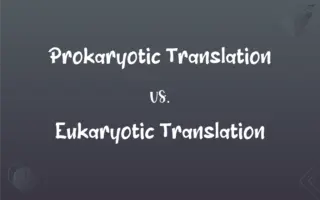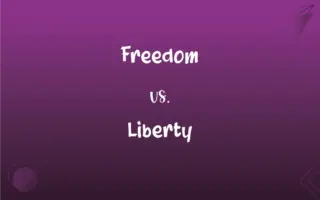Cc vs. Bcc: What's the Difference?
Edited by Janet White || By Harlon Moss || Updated on May 30, 2024
Cc means "carbon copy," sending email to additional recipients; Bcc means "blind carbon copy," hiding the recipients' identities.

Key Differences
Cc, short for "carbon copy," is a term used in email to indicate that a copy of the correspondence is being sent to the individuals listed in the cc field. Bcc, which stands for "blind carbon copy," also sends a copy of the email but keeps the recipient's address hidden from all other recipients.
When using cc, all the recipients, including those in the "To" field, can see who else received the email. On the other hand, when using bcc, the email addresses listed are invisible to everyone. This ensures privacy.
Cc serves the function of keeping individuals in the loop. It's a way to ensure that multiple people are privy to the same information. Bcc, conversely, is often used to protect the privacy of individuals who might not want their email address exposed to a wider audience.
There are many reasons one might use cc or bcc. For example, if you're sending a company-wide email, but only a few people need to act on it, they might be put in the "To" field with the rest in cc. Bcc can be useful for sending out a newsletter without disclosing the email addresses of all your subscribers.
Comparison Chart
Visibility
Visible to all recipients
Invisible to all recipients
ADVERTISEMENT
Main Purpose
Keeps people informed
Protects recipient privacy
Recipient Awareness
Recipients know who else received the email
Recipients don't know who else got the email
Usage Scenario
Informing a team about a decision
Sending newsletters without sharing addresses
Address Exposure
Email addresses are exposed to all
Email addresses are hidden from all
Cc and Bcc Definitions
Cc
Used to keep others informed of correspondence.
Always cc me on those reports, so I'm updated.
ADVERTISEMENT
Bcc
An email function to hide recipient addresses.
I'll bcc all the invitees so their emails remain private.
Cc
Indicates secondary recipients of a message.
The teacher will email the principal and cc the counselors.
Bcc
Protects the privacy of email recipients.
Always use bcc when sending out client lists.
Cc
A way to share information with more than the primary recipient.
I'll cc the rest of the group on our meeting notes.
Bcc
Stands for "blind carbon copy" in email terminology.
For large mailings, it's courteous to use bcc.
Cc
An email feature to send copies to additional recipients.
I'll send the memo to the manager and cc you.
Bcc
Sends emails without revealing all recipients.
I bcc'd the team so nobody knows who else got the memo.
Cc
Abbreviation for "carbon copy" in digital communication.
Please cc all team leads on the project update.
Bcc
Used to discretely inform or notify without alerting other recipients.
I'll bcc the supervisor about the ongoing issue.
Cc
A carbon copy of a document.
Bcc
Initialism of blind carbon copy
Bcc
Initialism of body-centered cubic
Bcc
To send something by blind carbon copy.
FAQs
Can bcc recipients see each other's email?
No, all bcc addresses are hidden.
Can someone know if they've been bcc'd?
Only if they see the email in their inbox, but not from the email itself.
When should I use cc?
Use cc when you want others to be informed but not necessarily involved.
What does cc stand for in emails?
Cc stands for "carbon copy."
Is it rude to bcc?
Not if used appropriately, like protecting privacy or sending mass emails.
Does using cc imply a response isn't needed?
Typically, yes. Cc'd individuals are often just being informed.
Why is it called "carbon copy"?
It's a carryover from when carbon paper was used to make copies of documents.
Can a person in the bcc reply all?
Yes, but it will only go to the original sender and not other bcc recipients.
What's the etiquette for using cc vs. bcc?
Use cc for transparency and bcc to protect privacy.
Does cc or bcc affect email delivery speed?
No, both function the same way in terms of delivery.
How does bcc differ from cc?
While cc shows recipients to all, bcc hides them.
Do people use bcc to exclude someone from a conversation?
Yes, sometimes bcc is used to discreetly move someone off a thread.
Do email platforms always offer both cc and bcc options?
Most do, but always check the specific platform you're using.
Are there limits to how many people I can cc or bcc?
Some email platforms have limits, so check with your provider.
What's the main advantage of bcc?
Privacy protection is the primary benefit.
Can I move someone from cc to bcc in an ongoing thread?
Yes, but it's best to inform them to avoid confusion.
Can you cc or bcc non-email entities like a phone number?
Typically no, unless the platform supports SMS integration.
Can I cc or bcc myself?
Yes, people often do this to keep a record.
Is it possible for bcc recipients to be accidentally revealed?
With most modern email systems, no. However, always be careful with email settings and plugins.
Should I inform someone if I'm going to cc or bcc them?
It's good etiquette, especially for bcc, to prevent unintended replies.
About Author
Written by
Harlon MossHarlon is a seasoned quality moderator and accomplished content writer for Difference Wiki. An alumnus of the prestigious University of California, he earned his degree in Computer Science. Leveraging his academic background, Harlon brings a meticulous and informed perspective to his work, ensuring content accuracy and excellence.
Edited by
Janet WhiteJanet White has been an esteemed writer and blogger for Difference Wiki. Holding a Master's degree in Science and Medical Journalism from the prestigious Boston University, she has consistently demonstrated her expertise and passion for her field. When she's not immersed in her work, Janet relishes her time exercising, delving into a good book, and cherishing moments with friends and family.































































